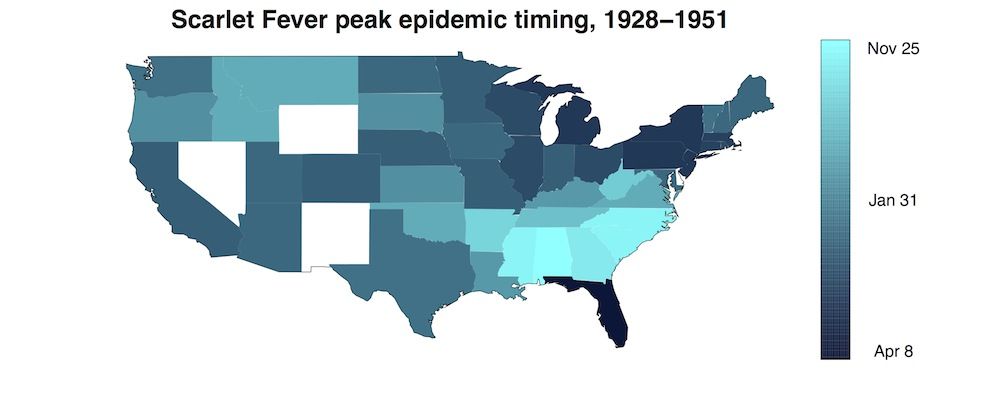Why Children's Diseases Move South to North Across the US

SACRAMENTO, Calif. — Newly discovered patterns in old outbreaks of childhood diseases, such as diphtheria and scarlet fever, could help modern disease fighters.
It turns out that both diseases swept across the United States from south to north, according to preliminary results from Kevin Bakker, a disease ecologist at the University of Michigan in Ann Arbor. In the United States, the wintertime epidemics hit first in the Southeast, and then spread northward during the 1920s to the 1950s. For example, scarlet fever peaked in Rhode Island a month later than in Alabama, Bakker found. Diphtheria followed the same pattern, but the disease spiked about a month before scarlet fever.
Though they are summer diseases, polio and typhoid fever also followed this geographic pattern during the same time period, Bakker reported Wednesday (Aug. 13) here at the Ecological Society of America's annual meeting. Polio hit earliest in the Southeast and Texas, and then reached Washington about six weeks later, he said. [7 Devastating Infectious Diseases]
The study relies on more than a century of newly digitized infectious-disease records from the Centers for Disease Control and Prevention (CDC) to provide a comprehensive view of disease patterns. The data comes from Project Tycho, an open-access database. Completed in November 2013, the project digitized the CDC's infectious-disease records dating back to 1888.
"There's never really been a study of peak timing for a few of these diseases," Bakker told Live Science. "We have these cool geographic patterns that nobody has ever seen before."
The south-to-north sweep suggests that environmental factors underlie the infections, even though they are transmitted in different ways, Bakker said. Diphtheria and scarlet fever are both bacterial, traveling from person to person on droplets spread by sneezes or coughs. In contrast, polio and typhoid fever are typically spread through fecal-oral contact, such as when a person drinks unclean water or eats food contaminated by a person's infected stool.
"No one has recognized these patterns for scarlet fever and diphtheria," Bakker said. "This is probably the most striking pattern for me, because we had these geographic clusters of early epidemics in the American Southeast months before the epidemics are occurring in the Midwest and the Northeast. There's really no known mechanism as to why this is happening."
Sign up for the Live Science daily newsletter now
Get the world’s most fascinating discoveries delivered straight to your inbox.
Bakker now plans to search for the reasons scarlet fever and diphtheria start first in the Southeast. Eventually, the findings could help control the spread of these diseases in developing countries, by showing the time of year when vaccination campaigns would be most effective.
The Project Tycho data also suggest that other childhood diseases rely on population density for their spread, rather than environmental or geographic factors. Measles, chickenpox, rubella and the mumps all peaked in March and April, hinting at a link to the school year and a return from winter holiday, Bakker said.
Email Becky Oskin or follow her @beckyoskin. Follow us @livescience, Facebook & Google+. Original article on Live Science.

Most Popular

